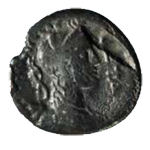Coin data
The as of L. Sulla
Open cardThe denarius of C. Hosidius
Open cardThe aureus of Nero
Open cardThe aureus of Vespasian
Open cardThe as of L. Sulla


Naples, National ARCHAEOLOGICAL MUSEUM, Coin Cabinet, As of L.Sulla, mint-moving with L.Sulla, 82 B.C. ©SSBAPES
- Laureate head of Janus; above, I
- Prow r.; above, L. SVL[A]; below, IMPE
- RRC 368/1; Inv. 6942/107; g 20,21; mm 33. RRC 368/1
The compound located along Via dell'Abbondanza, consisting of a shop with back-room and attached house, occupies the north-eastern corner of the eighth insula; the owners were most likely L. Vetutius Placidus and his partner Ascula, names appearing multiple times on the graffiti of the house; Vetutius' name is also repeated on numerous election programmes and some wine amphorae found inside. In addition to the lararium shrine representing Mercury, Dionysus and the snakes, the thermopolium, one of the best preserved and representative of the restaurant businesses that were widespread along the main streets of Pompeii, preserved its sales counter, whose top is covered with polychrome marble slivers and tiles and is complete with dolia embedded within the wall structure. A very interesting repository was found in one of these, consisting of 1,385 bronze coins worth a total of around 585 sesterces, maybe the shop's takings of several days. In addition to some sporadic finds from the first phase of the 1912 archaeological investigation and other recoveries in different rooms of the house or in the back-room, the very same thermopolium offers other interesting small groups of bronze coins, found in other dolia as well as on the sales counter, which were most likely daily takings, since they are not dissimilar in magnitude from those recovered in other restaurants of the same type. The sizable repository, made up exclusively of currency (1,385 coins), allows us to make some points, even if partial, on the circulation of bronze currency in Pompeii in 79 AD. The most used appears to be the as (63.3% of the total); the series attested by a greater number of specimens are those of the Flavian period (47.59%), chronologically closer to the date of the eruption; those issued by the Julio-Claudian dynasty come next (42.09%) followed by those of Galba (7.58%); although in very small percentages, the oldest coins issued by the Greek (0.14%) and Republican (1, 59%) mints are still present.
The denarius of C. Hosidius


NAPLES, NATIONAL ARCHAEOLOGICAL MUSEUM. Silver denarius of C. Hosidius, Mint of Rome, 68 BC ©SBAN.
- Bust of Diana r., draped, with bow and quiver over shoulder ; behind, GETA downwards; before III VIR
- Boar r., wounded by spear and attacked by hound; in exergue, C.HOSIDI
- Inv. 1455504/20; g 2,95; mm 17. RRC n.407/2
Numerous finds have come to light during the various stages of the House of Menander excavation, which occurred between 1926 and 1932 under the leadership of Amedeo Maiuri; the coins recovered in different areas of the home are extremely interesting, the most significant and famous find is the "treasure" kept in the cellar in a wooden crate containing a rich silverware set (108 pieces) consisting of drinking (argentum potorium) and table vessels (argentum escarium) and toiletries (argentum balneare), numerous fine jewellery pieces for both men and women that were placed in a wooden box with bone seals, and a stash of coins (13 aurei and 33 silver denarii) for a total value of 1,432 sesterces.
The bodies of some victims, mostly adults, were found in other rooms of the house, perhaps the servants who lived in the rural district who were attempting to reach the top floor to escape through the roof; next to them, four little stashes were recovered consisting of a few coins, their modest peculium. On the other hand, another discovery of particular interest is the stash consisting of two aurei and ninety pieces of silver (equivalent to 560 sesterces), perhaps kept in a leather bag, recovered in a cubicle of the slave quarters next to the bodies of an adult and a young girl; the finding in the same place of a bronze seal with the name of Q. Poppeo Erote has led to the hypothesis that the stash belonged to the procurator, the administrator of a home-based agricultural company, and that he needed it to meet the expenses of running the house and of the renovations in progress.
The aureus of Nero


NAPLES, NATIONAL ARCHAEOLOGICAL MUSEUM. Aureus of Nero, Mint of Rome, 68 BC ©SBAN.
- NERO CAESAR AVGVSTVS Laureate head of Nero r.
- AVGVSTVS AVGVSTA, Nero standing left, radiate and togate, holding patera and scepter, and Poppaea standing left holding patera and cornucopiae
- Inv. 161524 (57); g 7,35; mm 19. RIC I, 44.
An individual who was trying to leave the city heading towards Nocera met his death near the Sarnus Gate (III, 8); in his escape, he had tried to save his "treasure": a considerable stash of coins (49 denarii and 61 aurei; inv. 161468-161577), some jewellery, a fine mirror with embossed disk decorated with fishing Cupids, and four simple and elegant silver cups.
The aureus of Vespasian


NAPLES, NATIONAL ARCHAEOLOGICAL MUSEUM. Aureus of Vespasian, Mint of Rome, 75-79 BC ©SBAN.
- IMP CAES VESPASIANVS AVG Laureate head to r.
- R/ AETERNITAS Aeternitas standing l., holding the heads of Sol and Luna; to l. altar
- Inv. P.14273; g 7,35; mm.19; RIC II, pag.28, n.121a
A richly bejewelled lady from Pompeii, who was trying to flee with a wood and bronze box containing her liquid assets - 40 aurei (inv. 14270-17309) and 175 pieces of silver (inv. 14312) - met her death along with another adult and a child in the collapse of the balcony of the house located at no. 42 of Regio VI, Insula 17. The woman was wearing two rings and a precious, finely decorated, solid gold armband weighing 610g; as a result of this exceptional finding, the place was named the House of the Gold Bracelet.





